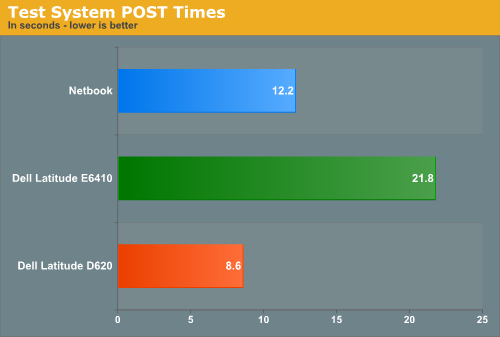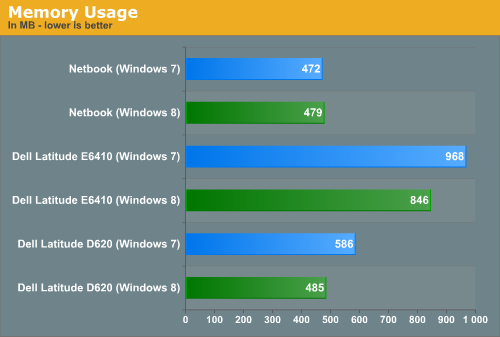In-Depth with the Windows 8 Consumer Preview
by Andrew Cunningham, Ryan Smith, Kristian Vättö & Jarred Walton on March 9, 2012 10:30 AM EST- Posted in
- Microsoft
- Operating Systems
- Windows
- Windows 8
To test claims of faster booting and lower memory usage in Windows 8, I installed a fresh copy of Windows 7 on each of three different computers of varying vintages—a Dell Latitude E6410 with 8GB of RAM and an SSD, a Dell Latitude D620 with 2GB of RAM and an HDD, and a lowly netbook with 1GB of RAM and an HDD. More complete specs for these systems can be found on this page, in which I discuss the computers on which I’ve been running Windows 8. Each computer had the most recent drivers for all of its hardware installed.
Startup time is defined as the amount of time between when the power button is pressed and when the Windows login screen is ready for input. POST time is defined as the amount of time between when the power button is pressed and when the “Starting Windows” boot screen first appears. After measuring all times in Windows 7, I reformatted the hard drives, installed Windows 8 and any needed drivers, and measured boot times in the same way.

Microsoft claimed that Windows 8 featured improved boot times, and that claim is definitely true—boot times vs. Windows 7 are down across the board. These reductions are due to some architectural changes that Microsoft has made—a Windows 7 shutdown would completely purge the OS and all running programs and user sessions from memory and then re-load a fresh copy at next boot. Windows 8 unloads the user session and running programs from memory, but saves the core OS to disk from RAM as it would do if the OS were hibernating. The result is a much faster startup time all around, even on mechanical HDDs. If, for whatever reason, your system doesn’t support hibernation (or if you’ve turned it off), these boot time advantages will evaporate.
But what's that, you say? How is a netbook that barely meets the minimum system requirements booting more quickly than a late-model Dell Latitude? Perhaps these numbers will clear things up:

This is one of the instances where hardware designed for Windows 8 will probably have an advantage over older hardware that has been upgraded—as you can see here, a computer’s time to POST is a larger than ever percentage of total boot time. Thanks to its newer hardware and SSD, the Latitude E6410 only takes four or five seconds (!) to boot to the login screen in Windows 8, but its nearly 22 second POST time means that both the Latitude D620 and the lowly netbook are ready to use more quickly. Systems designed for Windows 8, especially those configured to use UEFI instead of legacy BIOSes, can have drastically shorter POST times, and new computers equipped with SSDs may well go from powered-off to ready-for-input in just a few seconds.
To test claims of reduced memory usage, I took the same machines and let them idle at the desktop with only the Task Manager running. Both the Windows 7 and Windows 8 installs used the same drivers, so any background processes running on one OS were also running on the other OS.

We see marginally lower base memory usage in Windows 8 compared to Windows 7 on the two Dell laptops by a noticeable but not staggering amount. The netbook, with its 1GB of RAM, sees about the same base memory usage under both operating systems—because of the extra caching and preloading that's going on under the hood, my experience has been that Windows 6.x's memory usage increases when you give it more RAM to work with. That computers with 2GB and 8GB of RAM would have a higher base memory usage than a machine with 1GB of RAM shouldn't be surprising.
These slight savings won’t keep you from needing to upgrade your RAM if you’ve been thinking about it, but it’s impressive that Microsoft has been able to hold steady or slightly decrease the amount of RAM used in spite of the additional features (and remember, since Windows 8 includes both anti-virus and anti-spyware protection built in, these numbers should look even better after an install of Microsoft Security Essentials or another anti-virus package on the Windows 7 machines).










286 Comments
View All Comments
rs2 - Sunday, March 11, 2012 - link
Seriously? I do not want either of those things.Please tell me that these are artifacts of running Windows 8 on a system with an underpowered graphics card, or at least that the rounded corners and "glass" effects simply have not been built in to the preview version.
Andrew.a.cunningham - Sunday, March 11, 2012 - link
Square windows here to stay, not a big deal. Windows borders can get more or less opaque depending on your settings, just like in 7.rs2 - Monday, March 12, 2012 - link
Maybe not a big deal, objectively speaking, but it feels like a step backwards to me. Between that and Metro I'm seriously considering just sticking with Windows 7. It does everything I need in a way that I like, with no trade-offs being made to support touch-based devices (which my desktop isn't).I'm starting to get the feeling that Microsoft could have another "XP vs. Vista" debacle on its hands, no? Back then I switched to Vista but never really felt that it was a significant improvement until Windows 7 came around. I didn't hate Vista or think that it was worse than XP the way a lot of people seemed to, but I wasn't really thrilled with it either. Windows 7 was an unquestionable improvement over both Vista and XP, however.
Perhaps this time I'll stick with "legacy" Windows 7 until Windows 9 comes out.
Andrew.a.cunningham - Monday, March 12, 2012 - link
Totally possible! Especially so in businesses, which move more slowly and are only now rolling 7 out over XP.The rounded vs. square corners thing is a matter of taste, I guess. It does seem to be showing up everywhere - Lion killed rounded buttons in favor of squared ones too. It's not important to me, but I suppose it is a little "old-school." :-)
AnnonymousCoward - Sunday, March 11, 2012 - link
Every new OS simply needs an option to use the old UI. That would take away the fundamental reason why users don't want newer OS's.I refuse to use anything beyond XP. Vista's and 7's Explorer is less functional, and other various UI functionality is different for the worse. Likewise, IE7/8/9 have a topbar that lacks real functionality and can't be customized, unlike IE6.
DanaGoyette - Monday, March 12, 2012 - link
Here are a couple of oddities I've noticed:* Start screen... If you try scrolling horizontally with a touchpad, absolutely nothing happens. In the developer preview, I had to read online to find out why the danged thing wouldn't scroll.
* Split-up search sucks.
Try this in Windows 7: Windows key -> "featu". So long as you don't have, say, "bluetooth feature pack" installed, you can just press enter to get to "Programs and Features".
Try it in Windows 8: Windows key -> Featu. Down, down, enter, enter. 4 key presses required to replace the original 'enter'.
* Start screen, another thing to try: Windows 7: search for something, then press the "context menu" key on the keyboard. You should get the right-click menu of the highlighted item. Windows 8: you get the right-click menu for the textbox you're typing in!
* The boot process seems weird on my Intel 320 SSD. After the initial disk activity, it sits there doing apparently nothing (no disk activity) for over 30 seconds. Effective boot time is around 60 seconds, not including POST. For comparison, resuming from hibernate to the login screen takes only about 4 seconds.
* You ever try it on a pen-only (Wacom) Tablet PC? It's worse than a mouse, because it seems to actively disable the screen corner gestures -- they don't work with the pen OR the touchpad on that system.
Now, for a nifty thing to try: right-click in the lower-left corner of the screen.
mbf - Monday, March 12, 2012 - link
Fixed that error on page 3 for you:"..Microsoft insists that the PC is just another kind of tablet..."
vivekgarg79 - Monday, March 12, 2012 - link
I have x86 (32 bit) m/c. I want to develop metro UI app, using VS2011 for windows 8. Will VS 2011 (x86) work on top of Windows 8 consumer preview (x86)??haplo602 - Monday, March 12, 2012 - link
I read the first 3 pages, then skipped to the conclusion. I realised I don't give a damn about any new Windows/Tiles version. Happy Linux camper since Windows XP.The UI change will be a big jump. It will be interesting to see the outcome.
iwod - Monday, March 12, 2012 - link
I couldn't believe how positive this review was, from a technical user prospective.And it surely prove M$ has little to no understanding of how UI should be designed. There is now Metro, and a half baked Desktop environment. I can see more user jumping on to Mac platform when Windows 8 comes out.
I think the root of all wrong doings; Tablet is just another PC. Which is where it all goes wrong.
P.S - I have been forcing Metro on myself for week now. I can definitely say it "could" be a great Tablet OS. Desktop? I will pass.